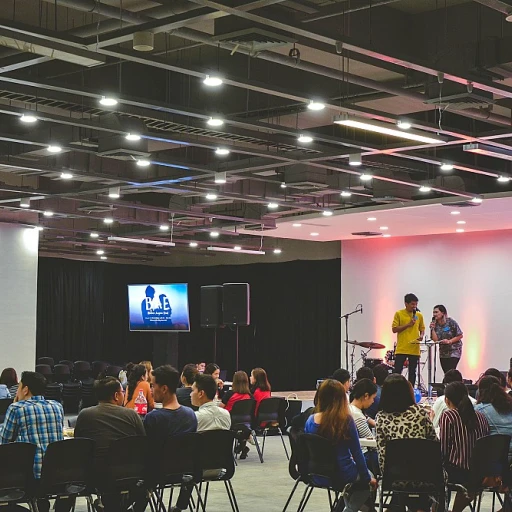
Understanding Internal Mobility
Decoding the Essence of Employee Movement within Companies
As organizations continuously evolve, internal mobility emerges as a crucial component in shaping vibrant workplaces. It is the practice of shifting talent within the company to different roles based on skills and business needs. This approach not only maximizes the existing talent pool but also encourages employees to explore various career opportunities within the same organization.
The core of internal mobility lies in recognizing the potential of your current employees and enabling them to diversify their skills. It’s not just about filling an immediate job vacancy; it’s a long-term talent management strategy that fosters employee engagement and development.
A successful mobility strategy often relies on a cohesive mobility program that aligns with the organization's goals. By deploying an effective internal recruitment process, companies can efficiently bridge skills gaps and drive business objectives forward. On the flip side, it empowers employees to follow personalized career paths, enhancing their employee experience and overall job satisfaction.
In considering internal talent movement, companies are encouraged to develop project-based assignments that allow employees to gain exposure to different aspects of the business. This not only aids in career development but also contributes to employee retention as they see clear paths for growth within the organization.
Benefits of Internal Mobility for Employers
The Organizational Upside of Internal Mobility
Internal mobility is more than just a buzzword in today's talent landscape. Companies are realizing the strategic advantage it brings to their overall business objectives. The ability to harness and redirect internal talent within the organization can significantly streamline hiring processes, reduce costs, and foster a culture of continuous development and engagement. When internal candidates are taken into account for new roles, it not only fills the skills gaps effectively but also enhances employee retention. Employees who see real opportunities for career pathing within the same organization are more likely to stay engaged and motivated. This motivation often translates into higher productivity, ultimately benefiting the company. Maximizing Resource Efficiency One of the most tangible benefits of a robust internal mobility program is resource efficiency. Traditional hiring processes can be expensive and time-consuming. However, internal recruitment utilizes existing resources, reducing the time and cost associated with onboarding and training new hires. Furthermore, employees transitioning into new roles are often already familiar with the company's culture, values, and processes. This familiarity enables them to hit the ground running, leading to quicker integration and better performance in their new positions. Enhancing Employee Engagement and Loyalty The success of any internal mobility initiative is largely contingent upon how employees perceive their career development opportunities. Having a clear mobility process that encourages skill enhancement and provides a roadmap for career growth can significantly boost employee engagement. Talent marketplace models and project-based roles offer employees diversified paths to explore new interests and develop new skills. When organizations prioritize internal talent mobility, they show a commitment to their workforce's growth, which fosters loyalty. It also encourages employees to proactively enhance their skills, knowing there are tangible rewards for their efforts within the organization. Driving Talent Management and Business Growth Organizations with effective mobility strategies in place not only enhance their talent management frameworks but also drive long-term business growth. By promoting career development through internal moves, a company can build a versatile and resilient workforce that is adaptable to changing business needs. Ultimately, these practices contribute to a more agile organization where employees are empowered to innovate and contribute meaningfully to their roles. Companies with strong internal mobility programs often find themselves better positioned to respond to market demands. For more insights into creating impactful career development programs within corporations, visit Crafting Effective Career Development Programs in Corporations.Employee Perspective on Internal Mobility
Internal Mobility From the Employee’s Eyes
When it comes to career growth and development, internal mobility offers a unique and inspiring path for employees to explore. Employees often value the opportunity to advance their careers within the same organization, as it allows them to build on existing relationships and deepen their understanding of the company’s operations.
The concept of talent mobility encourages employees to embrace new roles and challenges, enabling them to leverage existing skills while developing new ones. For many, this translates to a more fulfilling career path, reducing the need to seek external opportunities to progress.
Through an effective mobility program, organizations can identify internal candidates who possess the potential to fill skills gaps, ensuring a better alignment of talent with business needs. This not only nurtures the professional growth of employees but also strengthens the company’s capability to adapt and respond to industry trends.
One of the key aspects of employee engagement is providing a clear and attainable career path. By actively promoting internal recruitment and development opportunities, companies can enhance the employee experience and motivate their workforce to connect with organizational goals. These initiatives often prove to be more cost-effective than external hiring, reducing turnover and fostering a loyal workforce.
Not to mention, employees who participate in talent mobility initiatives may find a deeper sense of belonging and commitment to their employers. When companies invest in their employees’ growth, it leads to a more engaged and satisfied workforce. This investment also helps to sustain long-term business success by fostering a culture of continuous development and internal opportunity, empowering employees to own their career trajectories within the organization.
For more insights on how welcoming a new employee can boost internal mobility, visit our article on crafting the perfect new employee welcome email.
Strategies to Implement Internal Mobility
Building a Solid Framework for Internal Mobility
Implementing an effective internal mobility strategy demands a well-structured approach. Firstly, it's crucial for organizations to understand their workforce landscape by identifying existing skill sets and potential talent gaps. An internal talent marketplace can be instrumental here, allowing employees to explore available roles and opportunities within the organization.
Companies must ensure transparency in their mobility process, clearly defining career pathing options. This involves developing a robust talent management program that aligns with the organization's long-term goals and addresses identified skills gaps. Organizations can benefit from creating project-based roles to give employees the chance to develop new skills and broaden their experience.
Another key strategy is to promote a culture of continuous learning and development. Encouraging employees to acquire new knowledge and skills not only enhances their individual career paths but also adds value to the business. Providing access to training and development programs ensures that employees are well-prepared for new roles and responsibilities.
Incorporating technology, such as talent mobility software, can streamline the internal recruitment process. These tools help organizations match internal candidates with the right job opportunities, thereby optimizing employee experience and engagement while improving retention rates.
Communication plays a vital role in the adoption of internal mobility initiatives. Regularly communicating the benefits and opportunities of talent mobility can inspire employees to actively participate. Additionally, management should be encouraged to support and mentor employees through their transitions, fostering a supportive environment for growth.
Challenges in Promoting Internal Mobility
Roadblocks in Facilitating Smooth Talent Transitions
The path to establishing an effective internal mobility strategy is not without its hurdles. Organizations aiming to enhance career growth through movement of talent within their boundaries often face several challenges. Understanding these barriers is crucial to mitigating their effects and designing a seamless internal mobility process. One of the primary challenges in promoting talent mobility is the absence of a coherent and well-structured approach. Many companies lack a clearly defined mobility program or strategy, making it difficult for employees to understand the available career paths and opportunities. This can lead to underutilization of skills and potential frustration among employees. Organizations may also encounter resistance from managers who are reluctant to let go of key employees for fear of disrupting their team's dynamics or losing talent. This reluctance can stifle internal recruitment efforts and hinder the development of a robust talent pipeline. Moreover, companies often struggle with identifying and bridging skills gaps. To facilitate successful job transitions, it is essential to have a solid understanding of the current skills within the organization and those required for future roles. Without this insight, businesses may find themselves with a misalignment of talent and job requirements. From the employee perspective, there might be a lack of transparency in assessing eligibility for new roles. Employees often find it challenging to track their progression and understand what is needed to qualify for internal opportunities. This lack of clarity can diminish employee engagement and motivation. Furthermore, traditional talent management practices may not be agile enough to support a dynamic talent marketplace. A shift towards more project-based work can demand quicker adaptation and more flexible roles, which many existing systems are not equipped to handle. In conclusion, addressing these challenges requires a holistic approach that combines a clear internal recruitment strategy, supportive cultural shifts, and investment in employee development programs. By acknowledging and proactively tackling these challenges, businesses can create a more engaging and effective internal mobility framework that benefits both the organization and its employees in the long term.Measuring the Success of Internal Mobility Initiatives
Evaluating the Effectiveness of Your Talent Mobility Strategy
To accurately gauge the success of an internal mobility initiative, organizations must consider several key performance indicators and metrics that reflect both the program's efficiency and its impact on talent development.- Employee Retention Rates: A robust talent mobility program often leads to higher retention rates, as employees appreciate the career pathing and growth opportunities provided within the company. Monitoring these rates can signal the program's success.
- Internal Hiring Metrics: Tracking the percentage of roles filled by internal candidates as opposed to external hires is a critical way to measure the effectiveness of mobility programs. A higher ratio typically indicates a strong internal talent pool and successful internal recruitment strategies.
- Skills Development Tracking: Organizations should evaluate how well the mobility program addresses skills gaps. Tools to measure employee development, such as pre- and post-mobility assessments, can indicate whether employees are enhancing their skills as a result of new roles.
- Employee Satisfaction Surveys: Surveys can provide valuable insights into how employees perceive the mobility process and the opportunities they receive. Positive feedback often aligns with engaged and motivated talent.
- Alignment with Business Goals: It's important to ensure your mobility program supports the wider organizational goals. Measuring how well these internal changes contribute to business growth or project success will help align talent management with company objectives.
- Career Path Progression: Ensure employees' career development is progressing as planned. Monitoring the rate at which employees move through roles and projects can help gauge the long-term impact of the mobility initiatives.
- Return on Investment (ROI): Finally, assess the financial gains from the program. Calculate the expenses saved from reduced turnover and external hiring costs against the investment made in developing internal talent and mobility pathways.













